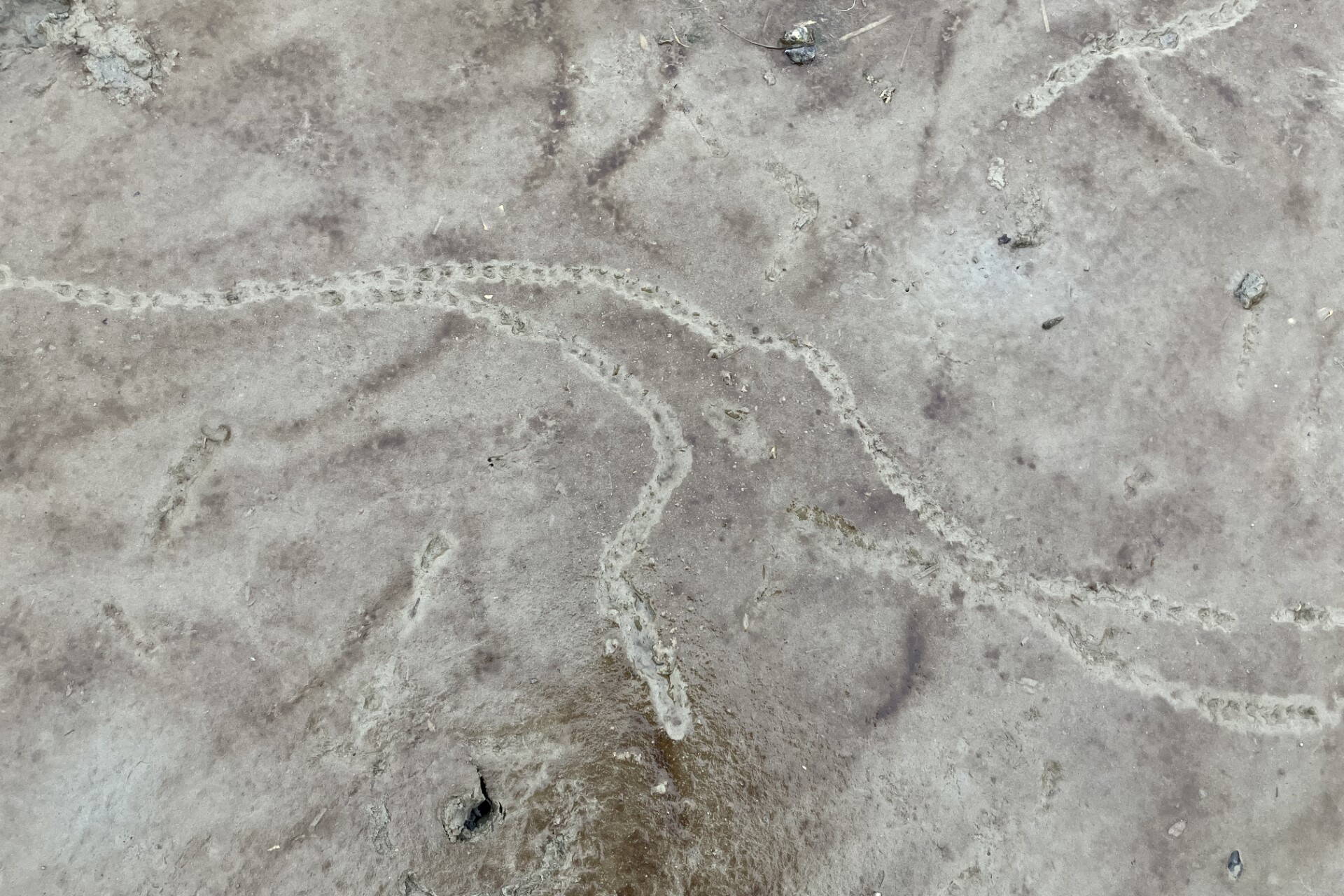One of my winter pleasures is traipsing around after a nice snowfall and looking for animal tracks. In mid-January, I walked up my driveway to the mailbox and crossed a clear trail left by a wandering porcupine on its way up the slope from the creek area toward the road. Looking more closely, I could see older tracks nearby, partly obscured by recent snow, showing that this critter (presumably the same one) had been this way not too long ago. It’s not the first time that I’ve noticed this apparent back-and-forth travel in that area, as if it is somehow convenient for the exploring animal.
Sometime in early January, I went to the meadows at the start of the Brotherhood Bridge trail. A little snow had fallen and conditions were good for showing signs of activity. In several places, I found long, raised ridges less than an inch wide, indicating the passage of some small beast tunneling through the snow. Given the size of the tunnel, I attributed these marks to shrews, supported in one case by the tunnel leading to a dime-size hole into a grassy tussock, visible where the tunnel roof had collapsed.
There were some slightly bigger trails leading to somewhat bigger holes into the vegetation, and these I called vole trails. Voles generally have a somewhat wider straddle than shrews do, thus making a wider trail. And red squirrels had been busy under the trees along the meadow edges.
All of that is quite ordinary stuff, yes, but fun to see and imagine the lives of the small ones. And you never know but what you might get a nice surprise, such as the marks of an owl’s wingtips.
The next day, I went with a friend to the Southeast Alaska Land Trust property along Montana Creek, using the trailhead near the bridge on the Back Loop. Here we found squirrel, vole, and shrew activity again, plus a probable mouse, with bigger hind feet and longer jumps. We also spotted a possible trail of a weasel, with smaller feet than a squirrel, making regular jumps of several inches. The main excitement was finding tracks of a small otter along the creek. This animal had crossed a snowy sandbar and come up onto the bank, where it had fossicked about, doing who-knows-what, leaving a sizable patch full of prints.
The big fun, however, happened at Eagle Beach, early in January. Out on the sand flats at low tide, we found some long, winding trails, looking to my imagination a bit like a bicycle chain had been pressed into the wet sand. I hadn’t a clue about the makers of those closely spaced tracks, but some helpful experts at NOAA immediately knew them for the marks of hermit crab. Of course, I wish I knew what the crab was doing and why those signs were concentrated in that particular place.
In the middle of January, I went to check some beaver dams along Dredge Creek. As expected, the beavers had not been very active recently, so the Beaver Patrol gets a little vacation. The creek was still flowing, and some otter-sized mammal had wandered out over the ice of a pond before the last bit of snow fell. Later, a mink(?) had cruised down the creek, bounding over the ice from one open water to another. And I found one set of snowshoe hare tracks; this may be a time when the population is low.
Back at my house, the fun was watching the action at the bird feeders. A group of chickadees was busy all day, clearly preferring the peanut butter feeders to the sunflower seeds. Each peanut butter feeder is a little block of wood about six inches long, with six pits drilled into it for holding the peanut butter. Sometimes a peanut butter feeder will host four chickadees at a time; if a fifth one approaches, it will either veer off or create a kerfuffle among the birds that were feeding, with birds flitting off in all directions. If there is just one chickadee at the feeder when another approaches, even though there is room for it to land and feed, I often see aggression between them, presumably the result of some dominance status issues—you can be sure they all know each other.
Juncos flit in and out, mostly scavenging seeds fallen from the seed feeders but sometimes going to the hanging seed feeders themselves and occasionally getting a bite of peanut butter. They usually come in ones and twos, but sometimes a whole flock appears and takes over, with lots of disorderly jostling. Most of the juncos are the usual Oregon type, but sometimes I see one of the slate-colored type from the Interior. Two red-breasted nuthatches come for peanut butter every day; I think they are a pair, but they come in separately. The suet feeder draws jays and a hairy woodpecker at different times; they tend to hang on that feeder for long minutes at a time, keeping all others away. The jays grab gobbets of peanut butter, usually in a quick visit. A male hairy woodpecker has also been on the peanut butter lately, and you can bet that nobody else comes in when he is there, although they check it out from a distance.
• Mary F. Willson is a retired professor of ecology. “On The Trails” appears every Wednesday in the Juneau Empire.

